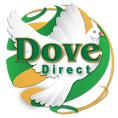Using VDP For Better Insurance Marketing Results
Welcome to the Dove Direct Print and Marketing Blog. Today's post, "Using VDP For Better Insurance Marketing Results," explores variable digital printing, aka variable data printing (VDP) mechanisms that increase response and engagement rates, thereby improving insurance marketing results. VDP technology is primarily suitable for incorporating personalization with direct mail marketing campaigns. Back in the day, direct mail marketing campaigns were used more generically and failed to differentiate the campaign relevancy, thus missing a good many of the targets. In an authentic sense, during those early days, direct mail marketing campaigns were akin to Michael Jackson's "This Is It" mentality, in that the messaging intent consisted of a "hey this is it, this is the message, and we hope you like it," and "that's all we have to say." Fortunately and thanks to VDP technology, we can now target recipients with a personalized direct mail message that can include a variety of demographic and psychographic data, complete with personalized creative, graphics, imagery, colors, messaging, calls-to-action, and language; while targeting household income, education levels, ethnicity, purchasing history, prior insurance history, zip codes, locations, and other pertinent data required by an insurance provider seeking to grow the bottom line. VDP is a game changer! Let's examine how to apply VDP to your next insurance marketing strategy.
Our Quote of the Day: "If an egg is broken by an outside force, life ends. If broken by an inside force, life begins. Great things always begin from the inside." — Jim Kwik
How Creative Design Engages Prospects
Just as the music industry states that an artist has about 10 seconds to capture the listener's interest to keep listening, so it is with direct mail pieces. Each direct mail recipient will either engage or not engage by reading a direct mail piece in about 10 seconds or less. Therefore, the first impression a direct mail recipient experiences are the attractiveness of the direct mail piece. Ideally, all creative print attributes and design considerations align with that recipient's preferences, starting with fonts, imagery, colors, and language.
It is critical to understand which design elements speak to the insurance type for various target consumers. For example, automotive insurance is different from life insurance, and home insurance is different from renters insurance, and so on. Automotive insurance marketing continues to rollout short stories that entertain while dealing with life surprises. You've seen them. Most have an entertainment focus from providers such as Allstate, Liberty Mutual, Geico, and Progressive. They freely embed humor with unbelievable life surprises, along with celebrities, short stories, and a dose of humor to attract new prospects.
Conversely, life insurance direct mail marketing approaches its target base with a more serious tone, promising peace of mind while offering stability and security in uncertain times. Home insurance and apartment insurance are also differentiators in the insurance game. One that we are all too familiar with is health insurance. Unfortunately, the spectrum of health insurance comprises a vast array of divergent offerings, whose target data can range from age to affordability, all focused on treatment types, health prevention, and maintenance.
That said, the beauty of VDP direct mail marketing initiatives is that all of those insurance types can adapt their direct mail pieces to target primary prospects and consumers. Even within the scope of a singular insurance product such as automotive, marketers should consider various demographic groups who likely have different needs. For instance, there are sets of divergent drivers representing Baby Boomers, Generation X, Millennials, and Generation Z. Each of these generations will likely require different creative for their direct mail piece, especially in terms of messaging. Think of it this way; you would not use senior citizen imagery when targeting a more youthful generation. In addition, young targets most likely require bolder colors. The use of fonts and messaging will also play a major role in accepting the direct mail piece, so it must speak to them. Each generation has a preference that informs them that this creative speaks directly to them, if not one-to-one. That is why data collection and management are vitally important in creating successful direct mail marketing campaigns.
Demographic Information is Key
While surveys indicate that direct mail marketing value has increased across several areas such as trustworthiness, personalization, and the ability to direct consumers to various, specific digital destinations, it isn't all stars and stripes. It is critical to understand that 20% of consumer targets have said that direct mail does not speak to their specific needs and may become irrelevant. With 20% of consumers being non-responsive to what they consider irrelevant messaging, there's room for brands to improve. Let's examine some data points that are guaranteed to come up when targeting various types of insurance.
Families and Marital Status
Life insurance marketing must take into consideration their target markets. To begin with, 20% of families have two parents and at least one child. Another consideration is how many families consist of one parent and at least one child or more? And what about families whose children are now grown and responsible for at least one child of their own?
Further, what about DINKS (double income, no kids)? The point here is that there is no blanket marketing approach to include relevant messaging for all of the divergent demographics. But again, the relevant data that needs to be collected will avoid direct mail pieces going straight to the trash can. The pertinent data for each of these groups can help determine the message, the graphics, and the overall creative that will ensure relevancy and lead to those prospects reading and responding to the direct mail marketing piece.
Demographics Have Changed
Over the past decade, insurance organizations' principal targets were primarily the highest-earning male sector of the population due to income levels that lead many to believe that this segment of the population could most afford its insurance premiums. However, that is far from today's reality. For example, back in 2002, African-Americans represented the largest retail product purchaser among all demographic groups. Fast forward to now, and people of color as a whole represent the fastest-growing share of purchasing power in the US economy.
According to Catalyst, "Latinx buying power ($1.7 trillion) surpasses the entire economies of all but 9 nations across the world. It is larger than the GDP of Canada but smaller than the GDP of Brazil." So while your insurance brand may not be targeting individuals outside of the United States, it's a good idea to compile some data on how that global trend may be rising or appearing in the United States, and most importantly, how to leverage up-to-date data information.
Multiple Locations
It is common for several insurance providers to operate in multiple states. If that is the case, geographic data collection is critical. That information will be of significant help in determining an insurance marketing strategy. There will be no monolithic marketing strategy for many divergent states. If a marketer uses a monolithic approach, the odds are strong that many recipients will throw that direct mail marketing piece in the garbage.
On the other hand, direct mail recipients are more amenable to receiving relevant, engaging messaging that focuses on their state, zip code, or county. They will also feel more confident purchasing from a local agent in their vicinity. Google states that insurance shoppers more likely want to talk with a person during all phases of their insurance buyer's journey. That translates into making the local shopping experience more accessible, complete with targeted, relevant communications. The bottom line, VDP helps achieve these goals when targeting different locales and addressing messaging concerns.
Print One Campaign with Multiple Variations
A brand can use VDP to alter various outputs for individual direct mail pieces that will not impede the printing process of a direct mail campaign or multiple campaigns. As stated earlier in this post, you can edit a direct mail piece and thereby change the text, colors, or images for each printed part so that each recipient receives an individually customized message. This process allows a brand to output as many targeted, personalized print pieces as required in a single run. It amounts to printing a single campaign, with the option of providing different variations based on your consumer data collection. Again, those data points can range from age, gender, location, or any other demographic the brand requires. VDP not only offers the capability to print 10,000 or ten million pieces and up but simultaneously does not interrupt or delay the running of the production process.
The Net-Net
The art of marketing in the insurance sector presents many challenges depending on the insurance category. While digital marketing is a mainstay for most sectors, including insurance, direct mail marketing is the most efficient manner to reach targets with personalized, relevant messaging that moves the ROI needle. People buy from whom they trust, and direct mail marketing is the most trustworthy medium of all. We hope you found value in this post. Thanks for reading "Using VDP For Better Insurance Marketing Results."
Let's have a conversation about integrated business solutions and how they can help grow your business, change behavior, and improve the customer experience.
Let us show you how to improve your document processes to optimize your workflow, reduce your costs, and maximize your organization's printing, letter shop, and mailing capabilities.
Dove Direct has an official USPS certified bureau located within our offices to save you time and money. We can even create a demo file for you. For more information, call Carla Eubanks at 404-629-0122 or email Carla at This email address is being protected from spambots. You need JavaScript enabled to view it..
Dove Direct, your Atlanta based print and mail solutions provider, offers organizations end-to-end data, printing, and mailing solutions:
- Data Management
- Variable Digital/Data Printing
- LetterShop and Fulfillment
- Digital Mail Scanning Services
- Fully Automated MLOCR Presort Bureau
- Marketing and Production Management Support
- Secure Data Life Cycle Management
If you don't want to wait, you can reach Dove Direct today by calling 404-629-0122 or use the Contact Form for Dove Direct.





